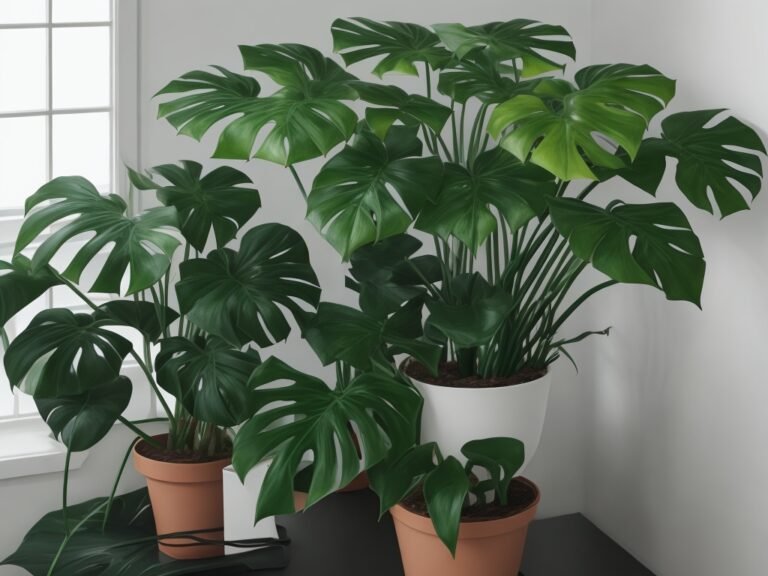Why Is My Monstera Sweating?
Key Takeaways:
- Monstera plants release moisture through their leaves in a process called transpiration, which can appear as “sweating.”
- Factors such as high humidity, overwatering, and low air circulation can contribute to excessive sweating in Monstera plants.
- Sweating is a natural and healthy process for Monstera plants and helps to regulate their temperature.
- Proper care, including providing adequate drainage and maintaining appropriate humidity levels, can help prevent excessive sweating in Monstera plants.
Have you ever looked at your Monstera plant and noticed droplets of moisture on its leaves?
It’s almost as if it’s working up a sweat! But why is it happening?
Well, my friend, you’ve come to the right place.
In this blog, we’ll dive deep into the fascinating world of Monstera sweating.
We’ll explore what it is, what causes it, and why it’s essential for the health of your plant.
Plus, we’ll also talk about how to care for a sweating Monstera to ensure it thrives in the best possible way.
Get ready to uncover the secrets behind your Monstera’s sweat!
| Causes of Sweating | Potential Solutions |
|---|---|
| High humidity | Reduce humidity in the room by using a dehumidifier or opening windows. |
| Overwatering | Allow the soil to dry out before watering again to prevent excessive moisture. |
| Lack of airflow | Improve air circulation by placing a fan near the plant or moving it to a more ventilated area. |
| Bright, direct sunlight | Move the plant to a shadier spot where it gets indirect sunlight or filter the light with a sheer curtain. |
| Pot bound roots | Repot the plant in a larger container to provide more space for the roots to grow. |
What is Monstera and why is it popular?
Monstera is a popular houseplant known for its large, unique leaves and tropical vibe.
People love it for its ability to bring a touch of nature indoors and its low-maintenance nature.
Popularity of Monstera as a houseplant
Monstera is extremely popular as a houseplant for several reasons.
Its stunning and unique foliage adds a touch of tropical charm to any space.
Monstera plantsonstera plants are relatively low-maintenance and can tolerate a variety of light conditions.
They also have a reputation for being resilient and easy to propagate, making them a great choice for both experienced and beginner plant enthusiasts.
The popularity of Monstera as a houseplant is further enhanced by its versatility – it can be grown in pots, hanging baskets, or even trained to climb up a trellis or moss pole.
All of these factors contribute to the widespread appeal and increasing popularity of Monstera as a beloved indoor plant.
Understanding Monstera’s water requirements
To care for your Monstera plant, it’s important to understand its water requirements.
Ideal watering routine for Monstera
To maintain a healthy Monstera, the ideal watering routine involves allowing the top inch of soil to dry out before watering again.
This typically means watering once a week or every two weeks, depending on the environmental conditions and the size of your plant.
It’s important not to overwater, as this can lead to root rot.
Remember to water thoroughly, ensuring that water reaches the roots, and allow any excess water to drain out of the pot.

Signs of overwatering
Signs of overwatering include yellowing or wilting leaves, root rot, mold or fungus growth, and a persistently damp soil surface.
Leaves may also become soft or mushy and may drop prematurely.
Be sure to adjust your watering routine if you notice these signs and allow the soil to dry out between waterings.
Signs of underwatering
Signs of underwatering include wilting or drooping leaves, dry and brittle foliage, yellowing or browning of leaves, slow growth, and soil that feels dry to the touch. The plant may also show signs of stress, such as leaf curling or development of brown tips.
Regularly checking the soil moisture and adjusting your watering routine accordingly can help prevent underwatering.

The phenomenon of Monstera sweating
Monstera sweating is a natural phenomenon where moisture accumulates on the leaves, giving them a wet, shiny appearance.
What is Monstera sweating?
Monstera sweating is when droplets of water or moisture form on the leaves of the Monstera plant.
It is a natural process that occurs when the plant releases excess moisture through its leaves.
The moisture can accumulate on the leaves, giving the appearance of sweat.
This sweating is a normal and healthy occurrence for Monstera plants.

Causes of Monstera sweating
Monstera sweating can be caused by a few different factors.
One common cause is excessive humidity, as these plants naturally thrive in humid environments.
Overwatering can also lead to sweating, as it creates a build-up of moisture in the leaves.
Lack of proper ventilation or air circulation around the plant can contribute to sweating as well.
Humidity and Monstera plants
Monstera plants thrive in high humidity environments.
Increasing humidity is essential for their optimal growth.
Importance of humidity for Monstera plants
Humidity is crucial for Monstera plants. It mimics their natural rainforest habitat, helping them thrive.
Adequate humidity prevents dryness, leaf browning, and promotes healthy growth.
You can increase humidity by misting the leaves, using a humidifier, or placing the plant on a pebble tray.
Natural habitats of Monstera plants and their humid environments
Monstera plants are native to the tropical rainforests of Central and South America, where they thrive in warm and humid environments.
These regions provide the perfect conditions for Monstera plants to grow, with high levels of humidity and consistent rainfall throughout the year.
In their natural habitats, Monstera plants can be found growing on the forest floor, climbing on trees, and even hanging from branches.
The humid environment helps to ensure the optimal growth and health of these popular houseplants.
How to increase humidity for Monstera plants
To increase humidity for your Monstera plants, you can try these simple methods:
- Group your plants together to create a microclimate where moisture is trapped.
- Place a tray filled with water near your plants. As the water evaporates, it will increase the humidity.
- Use a humidifier specifically designed for plants. It will release fine mist and help maintain the ideal humidity levels.
- Mist your Monstera leaves with water regularly to provide them with some moisture.
- Use a pebble tray by filling a shallow tray with water and placing pebbles on top. This will create a humid environment around your plants.
- Consider placing your Monstera plants in a bathroom or kitchen, where humidity tends to be higher.
Potential problems caused by Monstera sweating
Excessive moisture can lead to problems like root rot and weakened plant health. Mold and fungus growth may also occur due to the high humidity levels caused by Monstera sweating.
Impact of excessive humidity on Monstera plants
Excessive humidity can have a negative impact on Monstera plants.
It can lead to mold and fungus growth, which can harm the plant’s health.
Additionally, high humidity can increase the risk of root rot and other diseases.
It’s important to maintain the right balance of humidity to keep your Monstera thriving.
Mold and fungus growth due to excessive moisture
Excessive moisture can lead to mold and fungus growth on Monstera plants. The increased humidity creates an ideal environment for these unwanted guests.
To prevent this, ensure proper drainage and avoid overwatering.
Consider using a dehumidifier or a humidifier to maintain optimal humidity levels. Regularly check for signs of mold or fungus and remove it promptly.
Tips to prevent problems caused by sweating Monstera plants
To prevent problems caused by sweating Monstera plants, ensure proper watering by allowing the top inch of soil to dry before watering again. Use well-draining soil and avoid overwatering.
Maintain a humidity level of 50-60% by misting or using a humidifier.
Provide adequate airflow and avoid overcrowding. Regularly inspect for signs of mold or fungus and take action promptly.
How to care for a sweating Monstera
To care for a sweating Monstera, adjust your watering routine, maintain proper humidity levels, and follow other care tips for healthy plants.
Adjusting watering routine for a sweating Monstera plant
To adjust the watering routine for a sweating Monstera plant, it’s important to find the right balance. Here’s what you can do:
- Assess the moisture levels in the soil by sticking your finger in about an inch. If it feels dry, then it’s time to water. If it still feels moist, hold off on watering.
- Water thoroughly when you do water, making sure the excess water drains out of the bottom of the pot. This will prevent water from sitting in the soil and causing excess moisture.
- Consider reducing the frequency of watering if the plant is consistently sweating. Giving it more time to dry out between waterings can help regulate moisture levels.
- Monitor the plant closely and adjust watering based on its needs. Remember, every environment is different, so it’s essential to pay attention to your specific plant to maintain proper moisture levels.
Maintaining proper humidity levels for a sweating Monstera
To maintain proper humidity levels for a sweating Monstera, you can follow a few simple steps.
Firstly, it’s important to provide your plant with the right amount of water.
Avoid overwatering, as this can lead to excess humidity.
Secondly, you can use a humidifier or place a tray of water near the plant to increase humidity.
Thirdly, consider grouping your Monstera with other plants, as they release moisture through transpiration, helping to create a more humid environment.
Remember to monitor the humidity levels with a hygrometer and adjust as needed.
Frequently Asked Questions
Can Monstera sweating damage furniture or walls?
Yes, Monstera sweating can potentially damage furniture and walls. The excess moisture can lead to water stains, wood warping, and even mold growth.
It’s important to place a saucer under the plant or use a moisture barrier to protect your surfaces.
Should I mist my Monstera to increase humidity?
No, misting your Monstera may not be the most effective way to increase humidity. Instead, try placing your plant near a humidifier or pebble tray, grouping it with other plants, or using a humidifying device.
These methods will provide more consistent and long-lasting humidity for your Monstera.
Is it normal for Monstera leaves to sweat during certain seasons?
Yes, it is normal for Monstera leaves to sweat during certain seasons. Monstera plants naturally release excess moisture through small pores called stomata on the underside of their leaves.
This sweating phenomenon helps to regulate the plant’s temperature and maintain overall health.
So, don’t worry if you notice your Monstera leaves sweating, it’s just their way of staying cool!
Can Monstera sweating indicate an underlying health issue?
Yes, Monstera sweating can indicate an underlying health issue. Excessive moisture on the leaves can be a sign of overwatering or poor drainage, which can lead to root rot and other problems.
It’s important to monitor the plant closely and adjust your care routine accordingly to ensure its health.
Final Verdict
Understanding why your Monstera plant is sweating is crucial for maintaining its health and preventing potential problems.
Monstera plants are popular houseplants due to their aesthetic appeal and lush foliage.
Proper watering routines and humidity levels are essential for these plants to thrive.
Excessive humidity can lead to mold and fungus growth, while low humidity can cause stress and leaf damage.
By adjusting your watering routine and maintaining proper humidity levels, you can ensure the well-being of your sweating Monstera plant.
Remember to monitor your plant’s condition and provide the necessary care for healthy growth.






